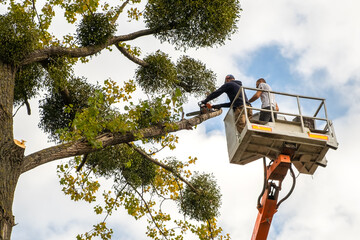Pruning Your Trees
Tree trimming is an important part of caring for your trees. It’s important to do the work at the correct time of year. Pruning during the fall or winter will stimulate the growth of the trees, but it can have negative consequences if the temperatures are too cold. Additionally, pruning can leave branches damp in the fall, leading to diseases and bacteria. Tree Trimming San Diego will minimize damage and improve the health of your trees.
 Branches should be pruned at an angle of about 45 degrees to the trunk. This allows water to drain away from the cut and prevents the bark from peeling. It is important not to cut a branch flush against the trunk, because this can weaken the tree’s structure. In addition, it’s important not to cut a branch more than halfway into the branch.
Branches should be pruned at an angle of about 45 degrees to the trunk. This allows water to drain away from the cut and prevents the bark from peeling. It is important not to cut a branch flush against the trunk, because this can weaken the tree’s structure. In addition, it’s important not to cut a branch more than halfway into the branch.
Trees are living organisms, and every cut will have a long-term effect. This means that you have to understand the needs of each type of tree. A big, healthy tree may not suffer from a heavy trimming, but a tree that is stressed or has a health problem could be severely damaged. You also must take into consideration stabilization and security issues, which can limit how much you can trim.
Pruning should be done in stages. You can start by removing suckers from the base of the trunk and then proceed to the top of the tree. You should also remove branches that are weak and dead. You should also cut away branches that rub together. You can also raise or reduce the height of the tree’s crown.
Tree pruning is an important part of landscaping, as it helps to keep your trees healthy and prevent them from falling onto your property. Proper pruning techniques will ensure that your trees are healthy and look their best while safeguarding you and your family. You should consult with an arborist if you’re unsure of the right pruning method for your tree.
Using sharp, clean tools when pruning branches is essential to the health of your trees. If you are pruning branches that have disease or pest infestations, be sure to disinfect your tools with disinfectant before you start. Make sure to avoid pruning upward-growing branches because it can lead to rot. When pruning branches that are growing downward, make sure to cut them sharply at the V-shaped angle and use stronger attachment points.
Pruning and trimming your trees will help them grow stronger and healthier. If you are not familiar with trimming, seek the advice of an arborist before starting a job. The results will be worth the effort, and you’ll be glad you took the time to do it. And it will be much easier than you think!
Tree pruning involves cutting back dead branches and leaves from your trees. The goal is to promote healthy growth and prevent diseases. Proper pruning will also protect your trees from falling branches. In addition to improving the overall health of your trees, it will ensure that your property looks better. By pruning, you can increase the sunlight reaching their lower branches and prevent overgrowth. In addition, it will encourage them to branch out and produce more fruit. These three reasons are a great investment in your property’s aesthetics.
Crown reduction is the most common type of pruning. By removing foliage from the ends of heavy branches, you can reduce the stress placed on the tree and allow space for structures above them. Crown reduction is most commonly performed on mature trees. It’s important not to remove more than one-third of the crown of a tree in a single year. If you notice a diseased branch, remove it immediately. Thin branches, on the other hand, can be trimmed anytime.
Tree topping is a dangerous process. Not only is it costly, it can cause decay and stress to the tree. Furthermore, it destroys the natural shape of a tree and leaves it vulnerable to disease. If you don’t want this to happen, consider another way of pruning your trees. Often, there are many alternatives to topping. Instead of cutting the branches, you can prune back the remaining branches to lateral branches.
Professional tree trimming requires several types of equipment. The tools you use will depend on the size of your trees and your ability to do the job. Some of the essential tools for tree trimming are shears, pruning saws, and gas powered clippers.





